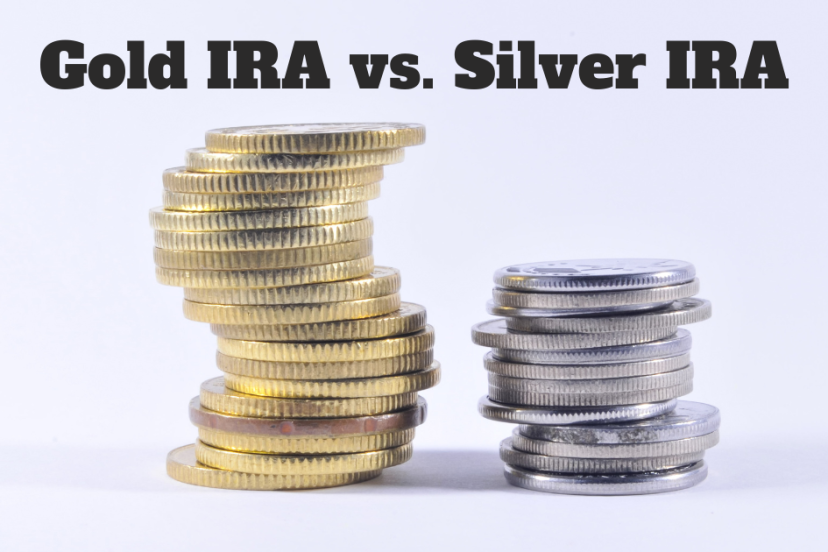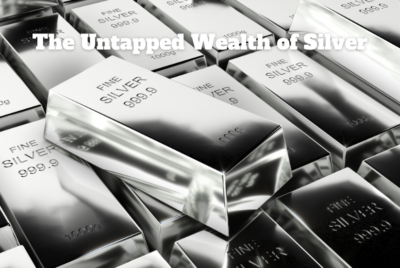Gold IRA vs. Silver IRA: Comparing the Benefits of Gold and Silver in IRAs
Gold IRA vs. Silver IRA is the topic of this article. As a passionate enthusiast and scholar of Gold IRA retirement planning, I firmly believe that making informed investment choices is crucial. When it comes to securing a comfortable and financially stable retirement. In this article, I will delve into the world of precious metal IRAs. Particularly focusing on the benefits of including gold and silver in Individual Retirement Accounts.
Introduction
When planning for retirement, many individuals turn to IRAs to build a nest egg that will support them during their golden years. IRAs offer various investment options, and among them, precious metals like gold and silver have gained significant attention. These tangible assets are renowned for their intrinsic value and have historically served as a hedge against economic uncertainties.
Understanding Gold IRA
A Gold IRA, as the name suggests, is an Individual Retirement Account that includes physical gold among its holdings. The appeal of a Gold IRA lies in the perception of gold as a store of value and a safe-haven asset during times of market volatility. By diversifying an IRA portfolio with gold, investors seek to protect their wealth from inflation and currency fluctuations.
One of the primary advantages of a Gold IRA is its potential to act as a hedge against economic downturns and geopolitical crises. When traditional financial markets falter, gold has historically proven to retain its value, providing investors with a sense of stability and security. Moreover, gold has a low correlation with other asset classes, making it an effective tool for portfolio diversification.
However, it’s essential to acknowledge that gold, like any other investment, comes with its own set of risks. The value of gold can be affected by factors such as changes in production costs, market demand, and global economic trends. Additionally, since gold is not a source of income, it may not generate regular dividends like some other investments.
Exploring Silver IRA
A Silver IRA operates similarly to a Gold IRA but involves the inclusion of physical silver in the investment portfolio. Silver, like gold, is considered a precious metal and possesses certain unique qualities that make it an attractive option for retirement planning.
One of the significant benefits of adding silver to an IRA is its affordability compared to gold. Investors with a more modest budget may find silver to be a more accessible entry point into precious metals. Additionally, silver has industrial applications, which can contribute to its demand and potential for price appreciation.
As with any investment, there are considerations to bear in mind when exploring a Silver IRA. Silver can be more volatile than gold, with prices subject to fluctuations based on industrial demand, global economic conditions, and supply levels. Investors must assess their risk tolerance and long-term investment goals before allocating a significant portion of their portfolio to silver.
Comparing Gold and Silver in IRAs
When comparing the benefits of gold vs. silver IRA, investors should carefully evaluate their investment objectives and risk appetite. Both metals offer unique advantages that can complement different investment strategies.
Historical Performance and Value Comparison
Throughout history, gold has been regarded as a symbol of wealth and prosperity. Its value has endured for centuries, making it a sought-after asset for preserving purchasing power. Silver, too, has demonstrated resilience in maintaining value over time, although to a lesser extent than gold.
The value of both metals can be influenced by economic factors, global events, and monetary policies. During times of economic uncertainty, gold has often outperformed other assets due to its safe-haven status. However, silver’s performance can be more closely tied to industrial demand, which can lead to more significant price fluctuations.
Portfolio Diversification with Gold and Silver
Diversification is a fundamental principle of investing, and precious metals like gold and silver offer diversification benefits to an investment portfolio. Their low correlation with traditional assets, such as stocks and bonds, means that they may not move in tandem with broader market trends.
Including gold and silver in an IRA can provide a degree of insurance against market volatility. If economic conditions lead to a decline in stock prices, the value of gold and silver may rise, mitigating potential losses in other parts of the portfolio.
Liquidity and Ease of Transactions
Gold and silver are highly liquid assets, meaning they can be easily bought or sold in various markets around the world. This liquidity ensures that investors can access their funds relatively quickly if the need arises.
Transactions involving gold and silver can be conducted through various channels, including specialized dealers, financial institutions, and online platforms. However, investors should exercise caution and research the credibility of the entities they deal with to avoid potential scams or fraudulent schemes.
Risk and Stability
Investing in precious metals, including gold and silver, carries inherent risks that investors must be aware of. The prices of these metals can experience substantial fluctuations based on market dynamics, global events, and investor sentiment.
Gold is often seen as a safe-haven asset, it is not immune to market volatility. External factors, such as changes in interest rates and currency values, can impact the price of gold. Similarly, silver’s industrial usage makes it sensitive to economic conditions and demand from various industries.
Investors should carefully assess their risk tolerance and investment objectives before allocating a significant portion of their IRA to precious metals. Diversification,
as mentioned earlier, is a key strategy to manage risk effectively.
Tax Implications
Both gold and silver can offer tax advantages when held within an IRA. However, the tax treatment of precious metals in IRAs can vary depending on the type of IRA and the specific regulations in place.
In most cases, contributions to a Traditional IRA are tax-deductible. Distributions are taxed upon withdrawal in retirement. Roth IRAs, on the other hand, offer tax-free distributions, but contributions are made with after-tax dollars.
With a Precious Metals IRA, the IRS allows investors to hold certain types of gold and silver coins and bars in their accounts. As long as the metals meet specific purity requirements, they can be held in the IRA on a tax-deferred basis until retirement.
Investors should consult with a qualified tax advisor or financial professional to understand the tax implications of holding precious metals in an IRA fully.
Long-Term vs. Short-Term Investment
The decision to include gold and silver in an IRA may also depend on an individual’s investment horizon. Precious metals like gold and silver are often considered long-term investments, particularly as hedges against inflation and economic instability.
For investors seeking to protect their retirement savings from erosion due to inflation over the years. Gold and silver can be valuable additions to an IRA. These metals have historically retained their purchasing power, making them potentially suitable assets for a retirement portfolio.
On the other hand, some investors may be interested in short-term gains and speculative opportunities. While gold and silver can experience price fluctuations in the short term, they are not typically viewed as assets for rapid capital appreciation. Investors with short-term objectives should carefully evaluate their risk tolerance and consider other investment options.
Storage and Security
Physical possession of gold and silver can present challenges related to storage and security. Unlike other financial assets like stocks and bonds, precious metals require secure storage facilities to protect them from theft or damage.
Many investors choose to store their precious metals in specialized depositories that offer secure vaults and insurance coverage. Depositories are equipped to handle the logistics of precious metal storage and allow investors to retain ownership of the assets within their IRAs.
When selecting a storage solution, it is essential to opt for reputable and well-established depositories with a proven track record of security and reliability.
Market Trends and Forecasts
The prices of gold and silver are influenced by various factors, including supply and demand dynamics, geopolitical events, and macroeconomic trends. Monitoring these market trends and expert forecasts can help investors make informed decisions about their IRA allocations.
Gold and silver prices can be impacted by changes in interest rates, fluctuations in currency values, and shifts in investor sentiment. Geopolitical tensions and global economic conditions can also play a role in driving demand for precious metals as safe-haven assets.
While past performance is not indicative of future results, historical trends can offer insights into how gold and silver have responded to specific market conditions in the past. Consulting reputable financial analysts and market experts can provide valuable perspectives when making investment choices.
Factors Influencing Prices
Understanding the factors that influence the prices of gold and silver is essential for investors seeking to optimize their IRA holdings.
Supply and Demand Dynamics
The availability of gold and silver in the market is a significant factor in price determination. Changes in mining production, recycling rates, and central bank reserves can impact the overall supply of these metals.
Similarly, demand for gold and silver can fluctuate based on various factors, including investment demand, industrial use, and jewelry consumption. Economic growth in emerging markets and technological advancements can influence the demand for silver, while global economic uncertainties can drive investment demand for gold.
Industrial Uses and Technological Advancements
Silver is widely used in various industrial applications, including electronics, solar panels, and medical equipment. As technology continues to advance, the demand for silver in these industries may increase, potentially impacting its price.
Investors should be mindful of the dual role that silver plays as both a precious metal and an industrial commodity when considering its inclusion in their IRAs.
Practical Tips for Investing in Gold and Silver IRAs
Investing in precious metals within an IRA requires careful planning and consideration. Here are some practical tips to help individuals make informed decisions:
Setting Investment Goals and Strategies
Before including gold and silver in an IRA, investors should establish clear investment goals and strategies. Consider factors such as risk tolerance, investment time horizon, and overall portfolio objectives.
Gold and silver can serve different purposes within an IRA, such as wealth preservation, portfolio diversification, or capital appreciation. Defining these objectives will help guide the allocation of assets effectively.
Working with Reputable IRA Custodians
Precious metal IRAs must adhere to specific IRS regulations and requirements. To ensure compliance and avoid potential penalties, investors should work with reputable IRA custodians who specialize in precious metal accounts.
IRA custodians can provide guidance on the types of gold and silver that are eligible for inclusion in IRAs and assist with the logistics of purchasing and storing these metals.
Best Practices for Portfolio Allocation
When incorporating gold and silver into an IRA, it is crucial to strike the right balance within the overall investment portfolio. Precious metals can play a role in diversification and risk management, but they should not dominate the entire portfolio.
The appropriate allocation of gold and silver will vary based on individual circumstances, investment objectives, and risk tolerance. A diversified portfolio may include a mix of assets, such as stocks, bonds, real estate, and precious metals.
The Role of Gold and Silver in Retirement Planning
Gold IRA vs. silver IRA can play a significant role in retirement planning. By providing a degree of protection against inflation and economic uncertainties. Precious metals in an IRA can offer you peace of mind, knowing that a portion of your assets is safeguarded against market fluctuations.
As retirement approaches, investors may consider adjusting their IRA allocation to align with their changing financial needs and goals. Working with a financial advisor can help individuals make well-informed decisions about their retirement planning strategies.
Conclusion
In conclusion, comparing the benefits of gold and silver in IRAs involves considering various factors. Including historical performance, diversification benefits, and tax implications. Both precious metals offer unique advantages that can enhance a retirement portfolio.
While gold is often seen as a safe-haven asset with enduring value, silver provides affordability and potential industrial demand benefits. Investors should carefully assess their financial goals and risk tolerance when determining the appropriate allocation of gold and silver in their IRAs.
Gold IRA vs. silver IRA like with any investment, conducting thorough research and seeking professional advice are essential steps to make informed decisions. Precious metals can serve as valuable additions to a well-structured retirement plan, providing protection and stability in an ever-changing economic landscape.
FAQs
1. **Is gold or silver a better investment for retirement?**
Both gold and silver can be valuable assets for retirement planning, but the choice depends on individual preferences and investment goals. Gold is often seen as a safe-haven asset with enduring value, while silver offers affordability and potential industrial demand benefits.
2. **Can I hold physical gold and silver in an IRA?**
Yes, certain types of gold and silver coins and bars that meet specific purity requirements can be held in a Precious Metals IRA. It is essential to work with a reputable IRA custodian that specializes in precious metal accounts to ensure compliance with IRS regulations.
3. **What role do gold and silver play during economic downturns?**
Gold and silver are often considered safe-haven assets during economic downturns. Investors may turn to these precious metals as a hedge against inflation and economic uncertainties. As they have historically retained their value during challenging economic times.
4. **Can the prices of gold and silver be volatile?**
Yes, the prices of gold and silver can experience substantial fluctuations based on various factors. Including global economic conditions, geopolitical events, and changes in investor sentiment. As with any investment, there is inherent risk in holding precious metals.
5. **How much of my IRA should I allocate to gold and silver?**
The allocation of gold vs. silver IRA should align with an individual’s overall investment strategy. Including risk tolerance and financial goals. There is no one-size-fits-all answer, and investors should seek professional advice to determine the appropriate allocation for their specific circumstances.
Remember, the key to successful retirement planning is a well-balanced and diversified portfolio that aligns with your long-term financial objectives.









